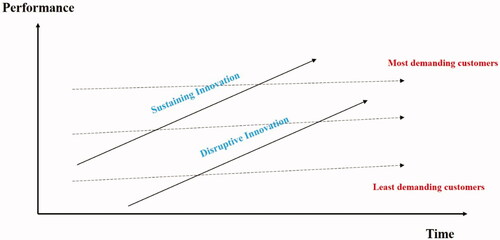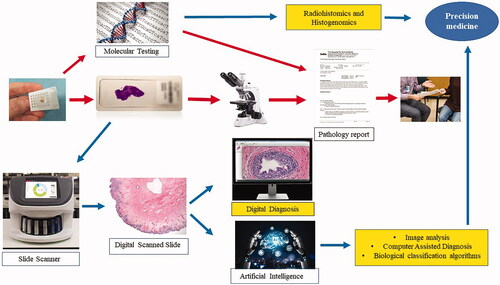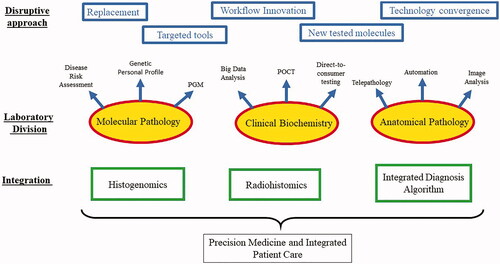Figures & data
Figure 1. Illustration of the concept of disruptive innovation. This figure depicts the difference between sustained and disruptive innovation. Sustained innovation is an incremental increase in an existing product/test aiming to enhance its performance. This usually leads to a more sophisticated test that is beyond the need of an ordinary customer. Disruptive innovation, on the other hand, is the creation of a product/test that is probably of less quality but has lower costs and suits the needs of regular customers/patients. Author/Copyright holder: Clayton Christensen. Copyright terms and license: All Rights Reserved. Reproduced with permission.

Figure 2. How disruptive innovation can revolutionize the workflow and outcome of pathology practice. The “classic” pathology workflow is indicated by the red arrows. The potential integration of image analysis and artificial intelligence is depicted by the blue arrows, and the potential added benefits of disruptive innovations are highlighted in yellow. In addition to creating a lenient workflow, image analysis can be an excellent tool for computer-assisted diagnosis by providing information beyond what the human eye can achieve. It can also create diagnostic algorithms to further classify disease into meaningful biological categories (prognostic and predictive). Eventually, the integration of molecular results and other diagnostic parameters (e.g. radiology and genomic data) will lead to enhanced precision diagnostics.

Figure 3. Approaches and impact of disruptive innovation in laboratory medicine. Disruptive ideas can enhance performance in all laboratory medicine disciplines. The top panel (blue) shows the different disruptive innovation approaches that can be explored in the clinical laboratory. These approaches can be used interchangeably among laboratory medicine disciplines (the middle panel). The middle panel (red) shows some examples of significant disruptive innovations in each of laboratory medicine divisions. Intradisciplinary and interdisciplinary integration (lower panel, green) will ultimately lead to a new era of precision diagnostics.

Table 1. Different approaches for disruptive innovation.
